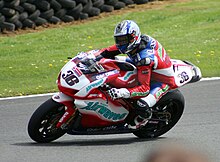Oulton Park
Oulton Park is a hard surfaced track used for motor racing, close to the village of Little Budworth, Cheshire, England.
The "Foster's" Circuit, which is 1.660 mi (2.672 km), comprises half of the "Cascades" corner followed by the "Hislop's" chicane, it then heads onto Knickerbrook and up the 13% gradient of Clay Hill to work its way round to the start/finish straight.
Deep kerbing on the inside of the corner combined with an off camber could easily affect a cars' handling causing it to veer to the outside of the circuit.
As an Armco barrier on the outside of the corner eventually intersected with the grass verge, there was a significant lack of run off area for drivers forced wide on the bend.
In the early 18th century the Oulton Estate comprised a manor house and a formal garden surrounded by Cheshire farmland.
[3] During the Second World War, Oulton Park's grounds were used as one of the staging camps for US Army units under the command of General Patton (he stayed at nearby Peover Hall) before the Normandy landings in 1944.
[4] American World Heavyweight Champion boxer Joe Louis put on several exhibition bouts for the troops garrisoned at Oulton Park.
With Sir Philip Gray-Egerton's permission, a circuit was mapped out starting early in 1953 and by August the new track was in existence, measuring 1.504 mi (2.420 km), almost rectangular in shape.
The main event of the day was the 33-lap 49.6 mi (79.8 km) Formula Two race, won by Tony Rolt driving Rob Walker's Connaught A Type.
[7] Oulton Park has a vast catchment area which includes Liverpool, Manchester, Chester and Crewe so it is little surprise that the second meeting and last of 1953, on 3 October, attracted a crowd of 40,000.
The car side of the day was confined to three Formula III races and a final, which was won by Glaswegian Ninian Sanderson from Ken Tyrrell.
It has something in common with Mallory Park in that it can trace its history back a very long way (possibly as far as Roman times) and is mentioned in Domesday Book as ‘Aleton’.
Alan Brown won the race in a Cooper-Bristol from Roy Salvadori, driving a Maserati A6GCS, who set a new lap record at 74.73 mph (120.27 km/h).
[7] 1965 saw the revival of the world's oldest motor race when the Royal Automobile Club's Tourist Trophy came to the Cheshire track.
[7] On 2 April 1966, prospective spectators at the British Automobile Racing Club's Oulton Park 200 were turned away, as the circuit was covered in snow.
Good Friday 1969 saw the birth of Formula 5000 in Europe: Peter Gethin had a runaway win driving the Church Farm Racing McLaren M10A.
Victory went to the Mexican Pedro Rodríguez, driving a Yardley BRM P160; he set a new highest race average speed at 115.13 mph (185.28 km/h).
[7] In 1987 a chicane was added between the Shell Oils Hairpin and Knickerbrook, with the intention of reducing speed to improve safety at what was the fastest section of the circuit.
At the close of the 2000 season the outright lap record on the International circuit stood to the credit of Gareth Rees, driving a Reynard 95D in the British Formula Two Championship on 6 July 1996.
[12] The Gold Cup was a prize originally awarded to the winner of a non-championship Formula One race held annually at Oulton Park.
[13] As of June 2024, the fastest official race lap records at Oulton Park are listed as: [65] The BRSCC's F5000 championship, organised in the UK but taking in events across Europe, started in 1969.


